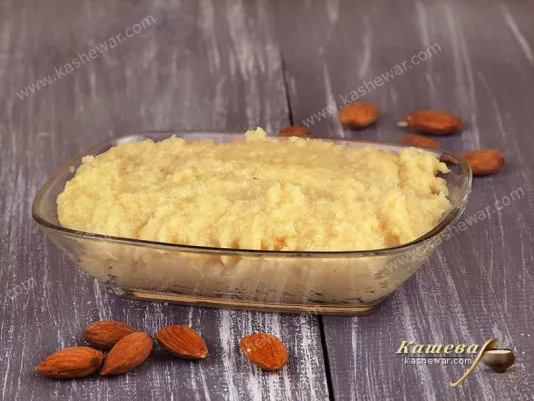Christmas Stollen (Weihnachtsstollen)
Some may find Christmas Stollen a bit too complex – both because of the number of ingredients and the process itself – but it’s well worth the effort.

Marzipan has always been a special ingredient for me, as it can transform an ordinary dessert into a work of art. Over many years of cooking, I have learned to work with marzipan mass in a way that makes it not only visually impressive but also delightful in every bite. In my practice, marzipan has served as the base for candies, a tender coating for cakes, and for making figures that decorated festive tables. I especially value its harmonious combination of almond aroma and sweetness, which pairs well with both fruit fillings and chocolate. My experience shows that the secret of success in working with marzipan lies in proper kneading and selecting high-quality almonds. Over the years, I have perfected a technique that creates the ideal texture: pliable yet firm. In my family, marzipan has always been associated with holidays, when we create sweet decorations together and share this taste of joy.
Over many years of cooking, I realized that the quality of marzipan depends primarily on the almonds. In my practice, I always choose almonds with a delicate flavor and a light kernel, as they give the mass a beautiful texture and pure aroma. I especially value marzipan made from raw peeled almonds, as it has a more pronounced flavor than that made from roasted ones. My experience shows that store-bought marzipan can vary greatly in quality: sometimes it is too sweet or too sticky. That’s why I always advise paying attention to the ingredients – quality marzipan should contain only almonds and sugar, with perhaps a bit of syrup. Over the years, I have developed the skill to evaluate marzipan by touch: it should be elastic but not too soft. In my family, we always prefer marzipan that can be shaped by hand without extra additives. This is one of those cases where authenticity and simplicity deliver the best result.
In my practice, I have found that even the best marzipan can lose its qualities if stored improperly. Over many years of cooking, I developed a rule: marzipan should always be wrapped in plastic wrap and stored in an airtight container. Moisture is its true enemy, so I never leave the mass uncovered. I especially value the option of keeping marzipan in the refrigerator: it doesn’t dry out or lose its aroma there. My experience shows that even homemade marzipan can remain usable for up to two weeks if packed correctly. In my family, we always make small batches to use right away and enjoy the fresh taste. Over the years, I also noticed that freezing doesn’t harm marzipan, but after thawing it can become less pliable. That’s why I use this method only when I need to store it for a long time. My experience proves that the key to storing marzipan is protecting it from air and moisture.
Over the years, I have mastered many ways of using marzipan in classic recipes. In my practice, this is primarily decorating cakes: a smooth layer of marzipan mass gives festive baked goods an elegant look. Over many years of cooking, I have learned to make thin sheets that easily cover a cake without cracking. In my family, we always made marzipan candies with fruit fillings – a classic dessert loved by both children and adults. I especially value marzipan combined with chocolate: these two textures and flavors create a harmony that is hard to replicate with other ingredients. My experience shows that marzipan can even be used in cookies or rolls, as it holds its shape well during baking. Classic recipes always teach restraint: marzipan should not dominate but complement and highlight other ingredients. That’s why I never use too much of it – balance is everything here.
Over many years of cooking, I observed how marzipan goes beyond classic desserts and becomes part of modern gastronomy. In my practice, it works wonderfully in ice cream, adding a distinct almond note to creamy bases. Over the years, I also experimented with marzipan in mousses and cheesecakes: a small amount of this mass creates new flavor depth. I especially value it in modern interpretations of fruit desserts, such as paired with orange or raspberry. In my family, we enjoy making small marzipan figures to decorate Christmas pastries, and this process always turns into a family ritual. My experience shows that marzipan can be not only decoration but also the main flavor accent. Modern chefs even add it to cocktails or creams for coffee drinks, and I have found that it truly works. It may surprise you, but marzipan pairs beautifully with spices such as cardamom or cinnamon. In my hands, it has become an ingredient that offers countless variations.
In my culinary practice, marzipan has always been an ingredient that requires patience and attention. Over many years of cooking, I realized that the secret is in proper kneading: almonds must be finely ground and combined with sugar to form a pliable mass. In my family, we always do this together, turning the process into a little celebration. I especially value the moment when marzipan can be shaped into a figure or a flower – in my hands, it becomes a material for creativity. My experience shows that marzipan demands care: if too much sugar is added, it becomes too hard, and if too little, it loses shape. Over the years, I have learned to sense the balance that allows me to create desserts of refined taste. Sometimes dishes failed due to haste, but those moments taught me to be more attentive. Marzipan is an ingredient that opens the door to a world of culinary creativity but requires respect. I always advise working with it calmly and with love, as only then does it reveal its true beauty.